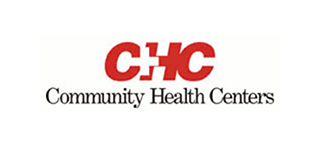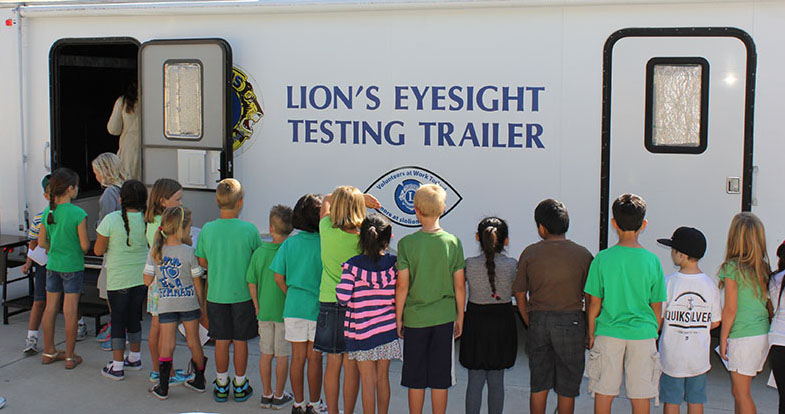 ATTENTION PARENTS!
ATTENTION PARENTS!
Important information about the Vision Testing your child received.
Helping Your Child be Visually Ready for School
The SLO Lions School Vision Screening Program provides access to professional eye care for all children in our county, at no cost to the family or parents. Community-minded optometrists, the Lions Service Clubs, and dedicated school nurses have worked together since 1960 to make sure all of our children are visually ready for school.
About the Visual Assessment Screening
The screening uses the Modified Clinical Technique of visual assessment, and is considered the “gold standard” of vision screening following the Optometric Clinical Practice Guidelines (OCPGs). It is a non-invasive screening and is not a full eye exam.*
The Visual Assessment Includes the Following 5 Tests:
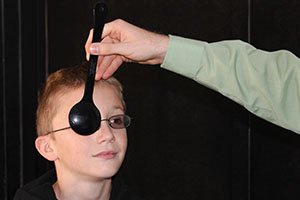 1. Visual Acuity testing is performed using a regular eye chart at 20 feet. The expected visual acuity for a child is 20/20. For the purposes of the screening, a child is considered to pass if they can see 20/40 or better with each eye alone. This is the standard that is used for passing the DMV test.
1. Visual Acuity testing is performed using a regular eye chart at 20 feet. The expected visual acuity for a child is 20/20. For the purposes of the screening, a child is considered to pass if they can see 20/40 or better with each eye alone. This is the standard that is used for passing the DMV test.
Some children, especially preschoolers and 1st grade students, may not read the chart because they are shy or don’t know their letters or numbers. Whether or not these children are referred for further testing is up to the discretion of the optometrist running the screening.
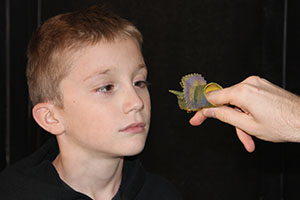 2. Binocular Screening is performed by a technician who checks the child for eye alignment and the ability to cross the eyes to look at near targets. Children are referred if any strabismus is found (when the eyes don’t work together) or if they have difficulty converging their eyes to look up close, which is necessary for reading and other book work. Click here for more information on strabismus.
2. Binocular Screening is performed by a technician who checks the child for eye alignment and the ability to cross the eyes to look at near targets. Children are referred if any strabismus is found (when the eyes don’t work together) or if they have difficulty converging their eyes to look up close, which is necessary for reading and other book work. Click here for more information on strabismus.
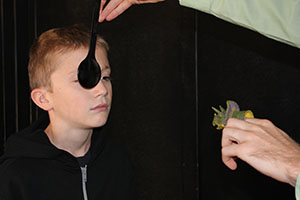 3. Refractive Error Estimation is when the child looks at a distant target and the optometrist estimates their refractive error using a retinoscope, a special instrument that measures how the child’s eye is focusing the light. The optometrist can determine if the child is nearsighted, farsighted, has astigmatism, or has a large difference in prescription between the two eyes.
3. Refractive Error Estimation is when the child looks at a distant target and the optometrist estimates their refractive error using a retinoscope, a special instrument that measures how the child’s eye is focusing the light. The optometrist can determine if the child is nearsighted, farsighted, has astigmatism, or has a large difference in prescription between the two eyes.
Refractive Errors Can Make School More Difficult – We Can Help
- Nearsightedness (myopia) makes it difficult to see things far away, such as the board in the classroom.
- Farsightedness (hyperopia) can make it harder to see things up close. A small amount of farsightedness is normal among school-aged children, but larger amounts can cause eyestrain, blurry vision, and sometimes even eye crossing. Farsighted children often struggle with reading and may appear lazy because they avoid doing near work.
- Astigmatism can make things look distorted at all distances. It has an association with problems copying from the board and difficulty in reading fluency.
- Anisometropia is a difference between the two eyes and makes it difficult to use both eyes together resulting in a lazy eye (amblyopia) in the eye with the higher prescription.
If any of these things are detected, the child will be referred for a full vision examination to see if glasses are necessary.
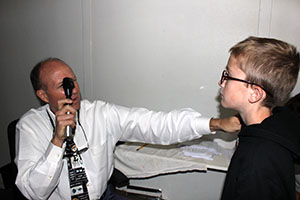 4. Ocular Health is determined within the limits of a screening test, as a thorough examination of ocular health is not possible. However, the optometrist will look at the eyelids and eyelashes for inflammation (a common condition among children). If the child has an unexplained reduction in visual acuity, the optometrist will also look inside the child’s eyes to see possible reasons for the reduction. Any eye health problems would result in a recommendation for referral.
4. Ocular Health is determined within the limits of a screening test, as a thorough examination of ocular health is not possible. However, the optometrist will look at the eyelids and eyelashes for inflammation (a common condition among children). If the child has an unexplained reduction in visual acuity, the optometrist will also look inside the child’s eyes to see possible reasons for the reduction. Any eye health problems would result in a recommendation for referral.
5. Amblyopia Detection is performed for kindergarten and preschool children. Amblyopia (or “lazy eye”) is the most common cause of vision loss in children. It is most commonly caused by eye teaming problems or a difference in refractive error between the two eyes. Most amblyopia is correctable if detected and treated early. Because many kindergarten and preschool children are unable to accurately read shapes or letters on a chart, a depth perception screening test (stereopsis test) using 3D glasses and a special target can be used in addition to the other tests to help detect amblyopia.
IMPORTANT NOTICE:
* Please note that the services performed are a screening only, taking about 1-2 minutes per child, and are not a substitute for a full eye examination in an eye care professional’s office. The purpose of the screening is not to prescribe eyewear and treat eye disease, but to determine which children are most likely to need glasses or other treatment. If your child is referred as a result of the screening, then you should schedule a full eye examination with an eye care professional (optometrist or pediatric ophthalmologist). Even if your child passes the screening process, you should schedule an examination if you suspect that your child has a vision problem or if you have a family history of vision problems. If your child has glasses, make sure they bring them to school as directed. The American Optometric Association suggests yearly exams for children with glasses or other visual disorders and biannual exams for well eye checks.

